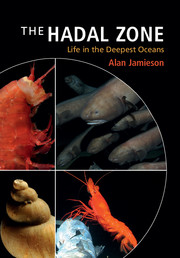Preface
Published online by Cambridge University Press: 05 February 2015
Summary
The hadal zone is an enigmatic ecosystem or rather a cluster of deep ocean trench ecosystems. It is not only one of the most extraordinary, extreme marine environments in terms of high hydrostatic pressure, geological instabilities and low food supply, the hadal zone is also a place where life has been found to thrive at such great depths, despite common perceptions to the contrary. The hadal zone represents one of the last great frontiers in marine science, accounting for 45% of the total ocean depth range, yet it receives little or no mention in contemporary deep-sea biology text books. In the 1950s, the hadal fauna were subject to a great deal of attention as a result of the Soviet Vitjaz and Danish Galathea biological sampling expeditions, the discovery of the deepest trenches and the first manned submersible dives into the trenches. The decade culminated in the first visit by humans to the deepest place on Earth, the Mariana Trench. Despite the myriad of public attention and the advances in our understanding of hadal biology, ecology and geology, interest appeared to dwindle and very little scientific endeavour occurred through the 1970s, ’80s and ’90s. In fact, during these decades, the hadal zone’s main accolade was as a potential dumping ground for pharmaceutical and radioactive waste materials, driven by the anthropocentric opinion of ‘out of sight, out of mind’. Thankfully, this exploitation and perturbation of trench habitats did not become common practice and in recent years there has been a renaissance in hadal exploration, almost certainly as a result of technological advances that have made this otherwise largely inaccessible frontier a viable subject for research. Furthermore, as the current resurgence continues to flourish, it is hoped that the hadal zone will, at long last, be placed equally alongside all other marine ecosystems. We face an uncertain climatic future and thus, the ocean must be understood and maintained in its entirety and not categorised by proximity to the nearest human. It is startling how little is known about the hadal environment and this lack of knowledge renders a limited view of the communities that survive at the greatest depths and endure the highest pressures on Earth.
- Type
- Chapter
- Information
- The Hadal ZoneLife in the Deepest Oceans, pp. xi - xiiiPublisher: Cambridge University PressPrint publication year: 2015



